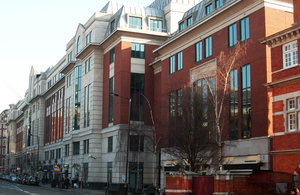Further progress on reducing ash cloud disruption
Reducing ash cloud effects from volcano Grimsvotn.

The volcano Grimsvotn has currently paused its eruptions and Met Office modelling indicates that significant disruption between now (25 May 2011) and the end of the weekend is unlikely, Transport Secretary Philip Hammond has said.
However, to help further reduce future disruption that could be caused if there are further eruptions or if the ash cloud returns to UK airspace, the Transport Secretary has held discussions.
The Transport Secretary confirmed that progress has been made in several key areas. Test aircraft are flying today to measure the density of the ash cloud, providing information to the Met Office to help refine the input data for its model. British Airways and Easyjet have also agreed to work with the CAA and the Met Office to provide information from their flights to help improve the model’s input data, with the aim of reducing the ‘red zone’ as much as possible. Furthermore, the Transport Secretary has asked NATS and the CAA to draw up procedures to allow flights to arrive and depart from the UK beneath the ash cloud and then gain altitude once they are safely clear of the ‘red zone’ - a technique known as ‘underflying’ - should the ash cloud return at high altitude.
Transport Secretary Philip Hammond said:
The new regime that we have established since last year has already significantly reduced disruption for passengers and airlines. If we still had the old regime in place, the whole of UK airspace would have been effectively closed for parts of yesterday.
I am pleased that, following discussions with the industry and regulators today, we have agreed further steps to reduce potential disruption, should the ash cloud return. Test aircraft are now flying through the ash cloud gathering information about its density, BA and Easyjet have agreed to provide further information to help us define the ‘red zone’ even more accurately in the future, and key steps have been taken to establish a new ‘underflying’ regime for UK airports.
Following meetings with British Airways and Easyjet, the two largest British airlines, Mr Hammond said:
We are constantly refining our ash forecasting methods and are keen to collect as much data as possible to help with this. Yesterday, satellite and lidar readings confirmed the presence of ash over Scotland and northern England, several aircraft made reports of encounters with ash to the Met Office and ash deposits were also found on aircraft and on vehicles in Orkney.
I welcome the support of airlines who want to help us gather further data and I am pleased that British Airways and Easyjet, as the two largest UK carriers, have agreed to participate in this process.
Further information
Improvements in last 12 months
In April 2010 the established aviation guidance was simply for aircraft to avoid flying in any concentrations of ash. Many steps have been taken in the past 12 months to ensure the UK is now much better prepared to deal with an ash eruption. Improvements include:
- installation of a new ground-based radar in Iceland which is providing accurate data on the ash plume height, the acquisition of specially adapted weather balloons for local observations and development of new satellite technology that allows the height and concentration of ash to be measured rather than just its movement
- intensive work by aircraft and engine manufacturers and regulators to better understand the effects of ash on aircraft, leading to tolerance levels being increased by a factor of 20 since April last year
- a new regulatory safety regime dividing ash clouds into three zones, allowing airlines to fly in low concentrations of ash and - in conjunction with their airframe and engine manufacturers - to submit a safety case to the CAA to fly in medium and high densities of ash
Ash observations reported to the Met Office yesterday, Tuesday 24 May included:
- a plane flying from Aberdeen to the Shetlands encountering volcanic ash during the flight with ash being deposited on the aircraft
- ash deposits found on a plane that had be flying in the Orkney area
- a plane flying from Stansted to Belfast observing a layer of ash to the north /northwest of the flight path
- a plane flying at a height of 18,000 feet in the Manchester area observing a layer of ash approximately 1000-2000 feet thick
- that ash has been deposited on vehicles on Orkney
- the research ship Discovery entered an area of thick volcanic ash on Monday between Scotland and Iceland with ash being deposited onboard
- satellite and Lidar observations confirming the presence of ash over northern Britain in the last 24 hours
- air quality sensors across Scotland indicating an increased amount of ash particles (PM10s).
Aviation, maritime and technology media enquiries
Media enquiries 0300 7777 878
Switchboard 0300 330 3000